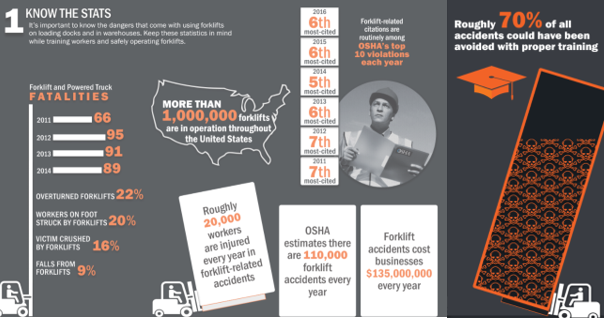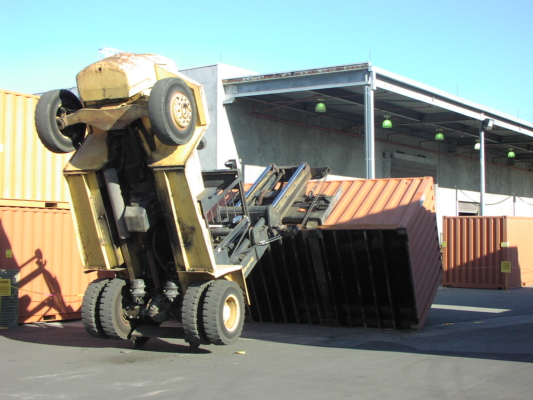Powered industrial trucks, commonly called forklifts or lift trucks, are used in many industries, primarily to move materials. They can also be used to raise, lower, or remove large objects or a number of smaller objects on pallets or in boxes, crates, or other containers. These powerful machines can also be dangerous and therefore it is important that all forklift operators have proper training and follow strict forklift safety guidelines.

Training Requirements for Forklift Safety
- Prior to operating a powered industrial truck, every operator must undergo training. Training shall consist of a combination of formal instruction (e.g., lecture, discussion, interactive computer learning, videotape, written material), practical training (demonstrations performed by the trainer and practical exercises performed by the trainee), and evaluation of the operator’s performance in the workplace.
- All operator training and evaluation shall be conducted by persons who have the knowledge, training, and experience to train powered industrial truck operators and evaluate their competence.
- An evaluation of each powered industrial truck operator’s performance shall be conducted at least once every three years.
Certification Requirements
- The employer shall certify that each operator has been trained and evaluated. The certification shall include the name of the operator, the date of the training, the date of the evaluation, and the identity of the person(s) performing the training or evaluation.
Maintenance Requirements
- Industrial trucks shall be examined on a daily basis before being operated. Any repair defects which affect forklift safety shall be handled immediately before operation of the forklift can resume. Where industrial trucks are used on a round-the-clock basis, they shall be examined after each shift.

Safe Operation Requirements
- Make sure the load is balanced and fully secure to prevent a forklift from tipping over
- Ensure both forks are as far under the load as possible before lifting
- Drive with the load as low as safely possible
- Pay attention to posted speed limits and warning signs
- Always look in the direction you’re traveling; if a load blocks the view ahead, travel in reverse
- Steer clear of areas where forklifts are prohibited or restricted
- Keep an eye out for signs, floor marking, and other warnings for pedestrians and forklifts
- Use the horn at intersections and in areas where pedestrians may be present.
Keep checking www.narfa.com for more safety updates and tips and for more information about our nationally recognized workers compensation program in Massachusetts, please contact us today.
Recent Posts
The U.S. Department of Labor Announces Proposed Rule To Protect Indoor, Outdoor Workers From Extreme Heat
The U.S. Department of Labor has proposed a new rule aimed at protecting workers from extreme heat hazards. This initiative seeks to safeguard approximately 36 [...]
Supreme Court Overturns Chevron Deference: What It Means for Workplace Safety and Regulation
The landscape of federal regulation is set for a seismic shift following a recent Supreme Court decision. On June 28, in Loper Bright Enterprises, et [...]
Navigating the Compliance Maze: How NARFA Simplifies Employee Benefits for Automotive and Trade Industries
In today's complex regulatory environment, businesses in the automotive, roads, fuel, and related industries face unprecedented challenges in managing employee benefits. Recent studies show that [...]




